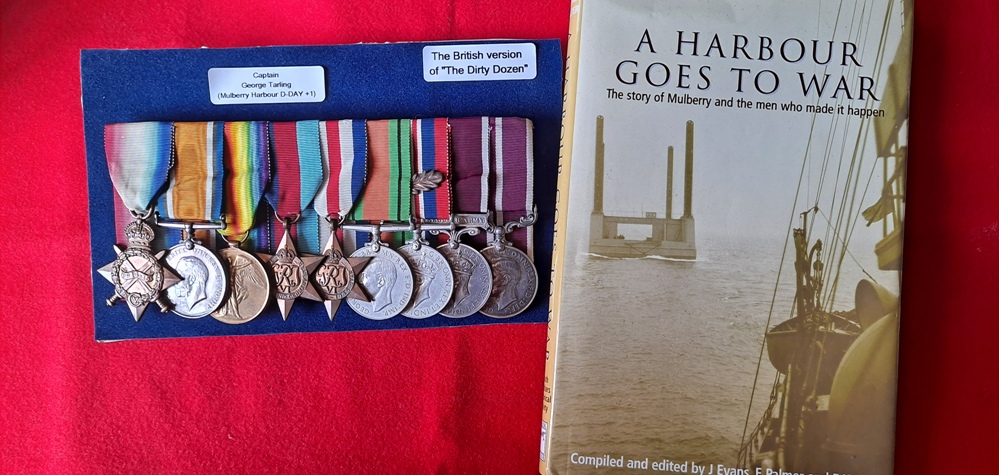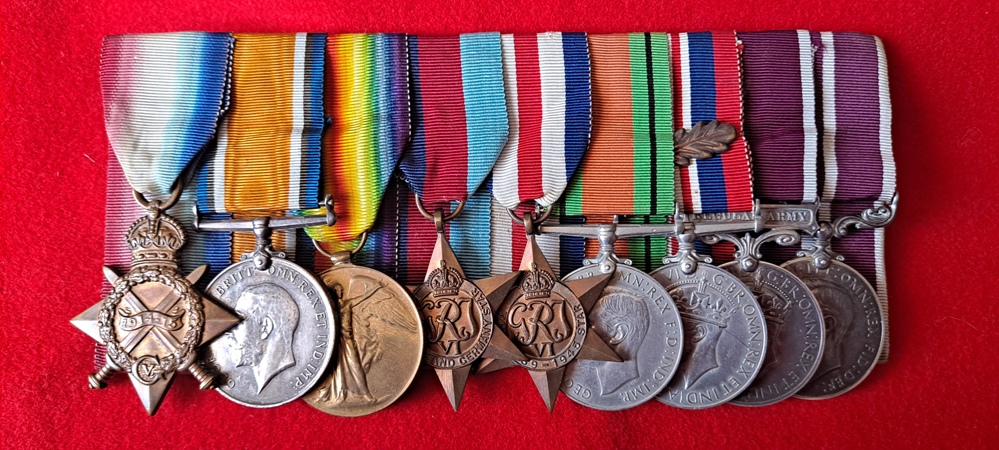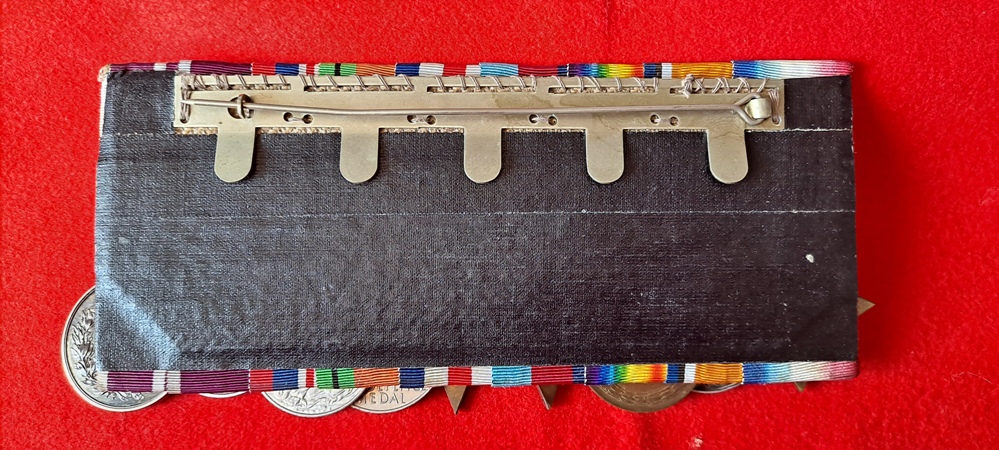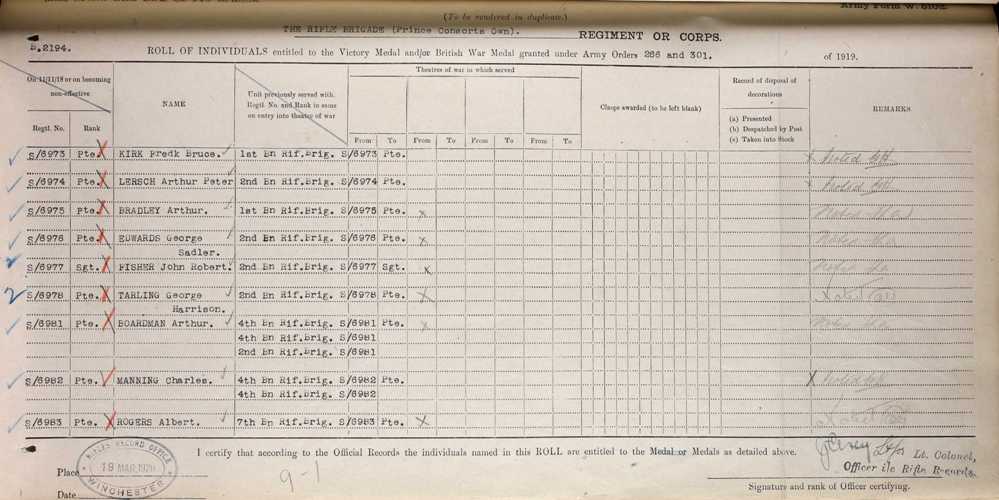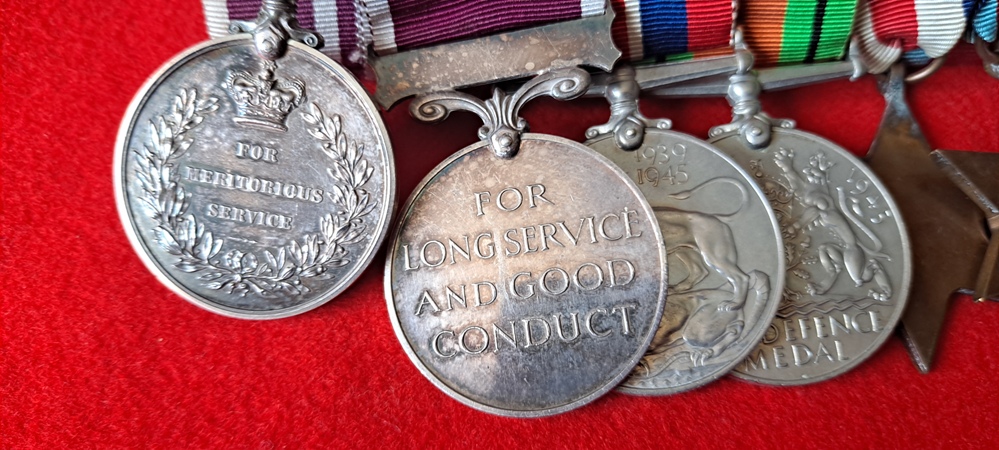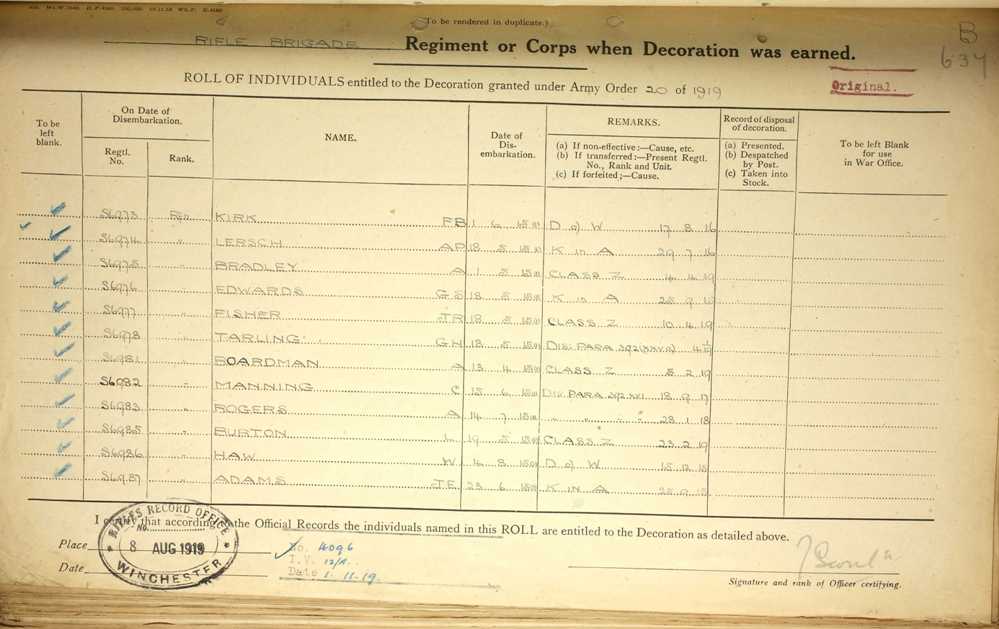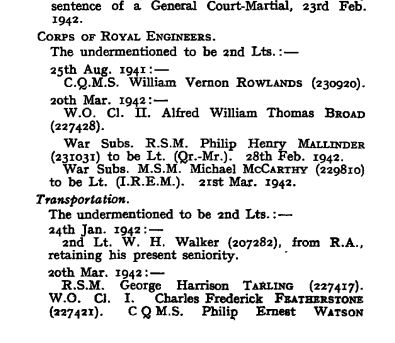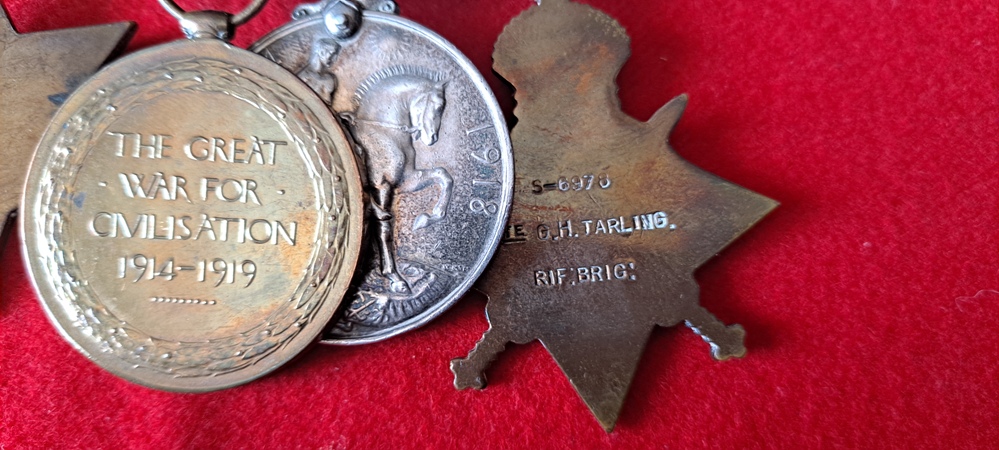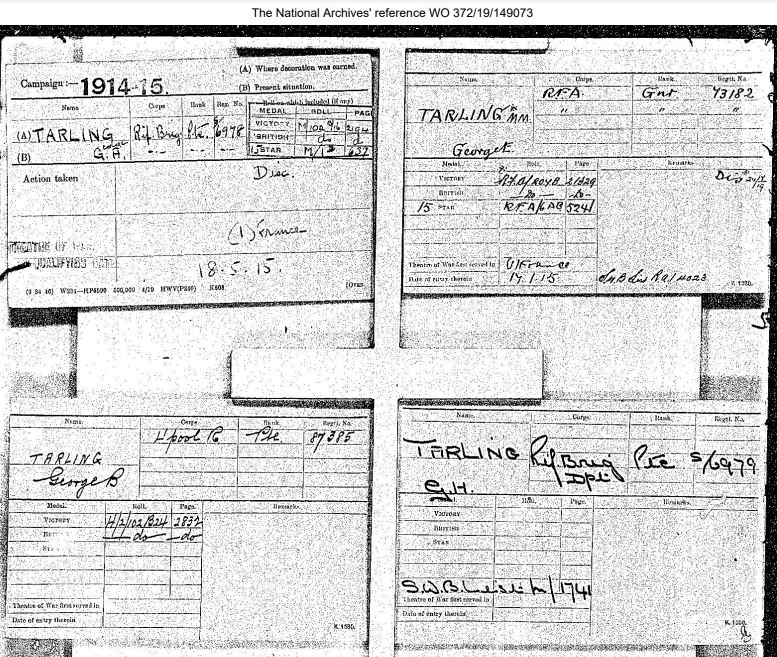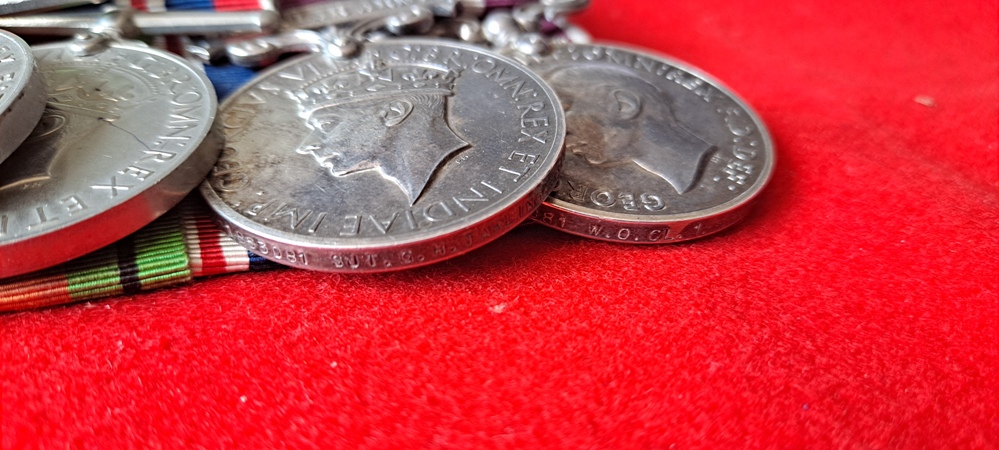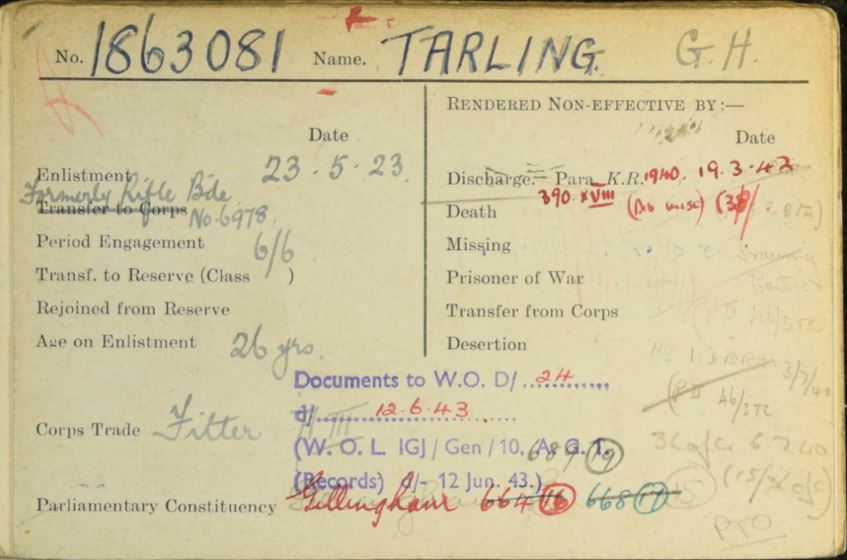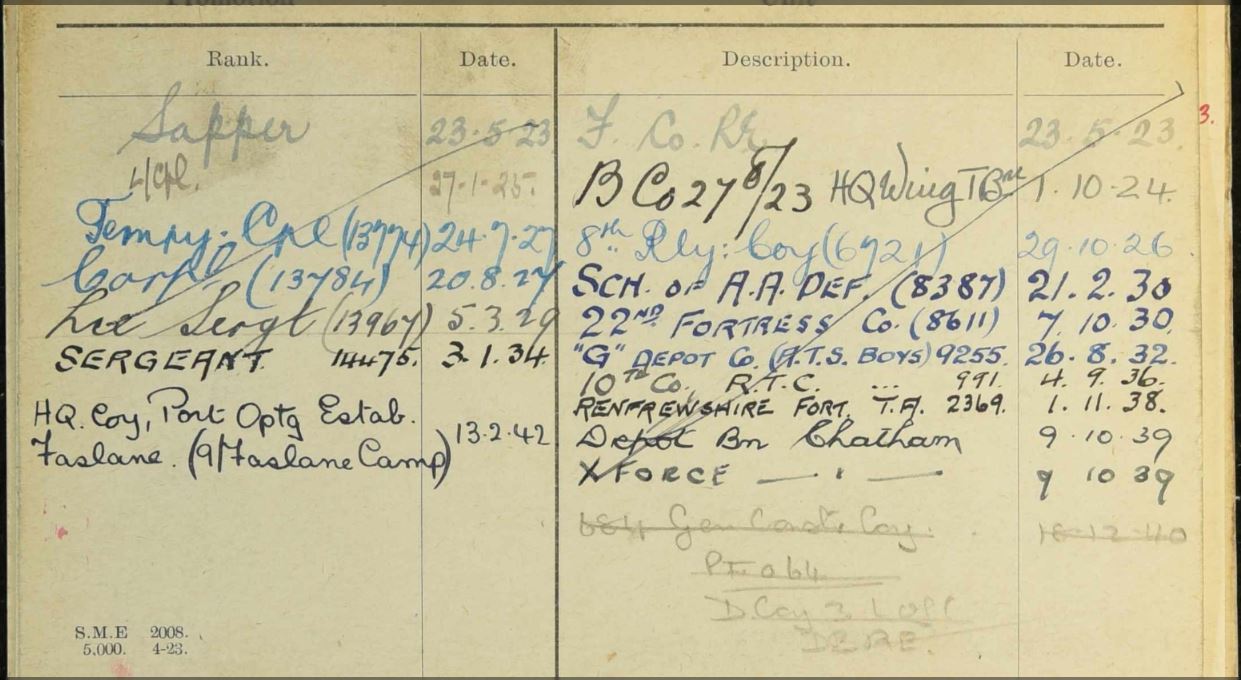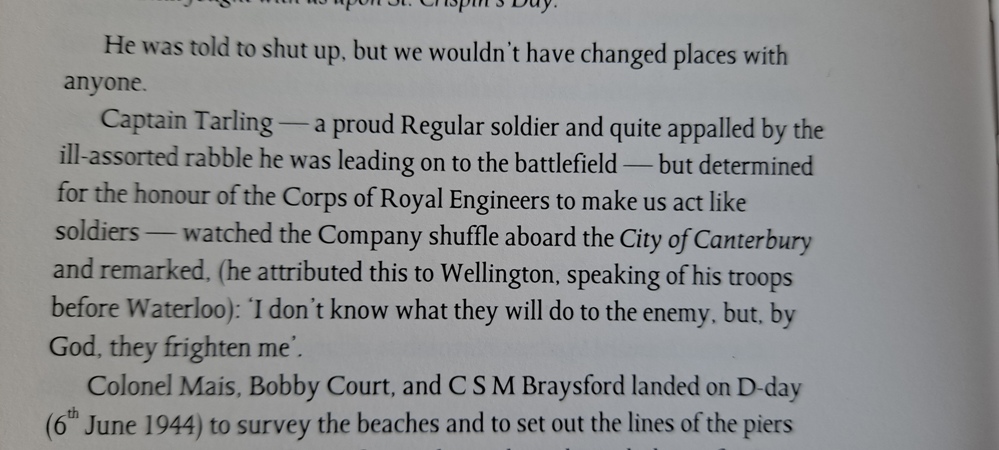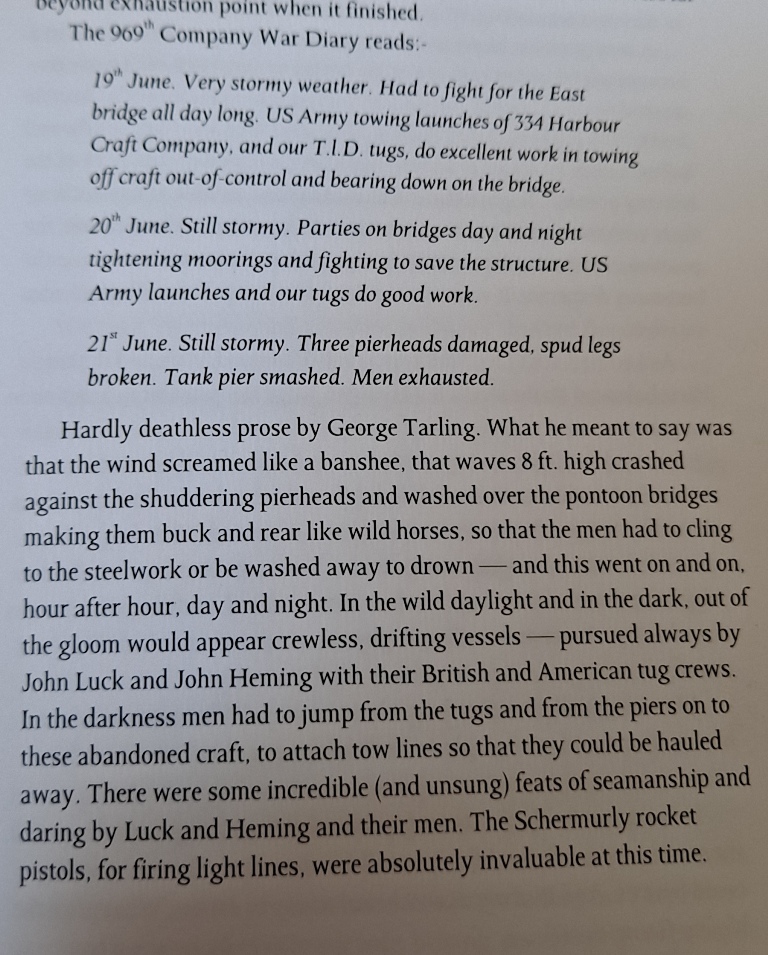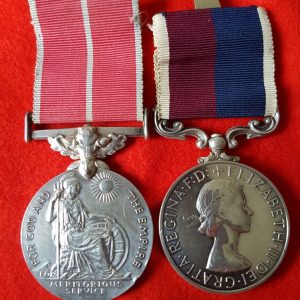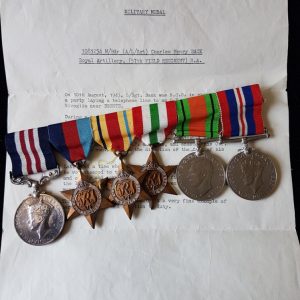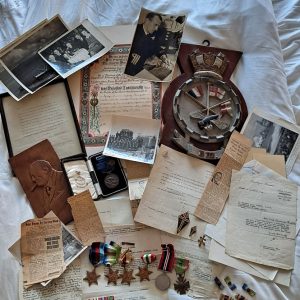Description
The superb and important medal group to Captain George Harrison Tarling who, having served in the Great War, played a pivotal role in the successful building of the Mulberry Harbour, Normandy.
He is “One of the men who made Mulberry happen” Captain George Harrison Tarling, Royal Engineers.
He served in the Great War in the Rifle Brigade and entered France 18th May 1915 and 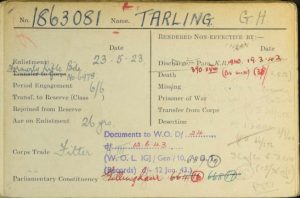 transferred from the Rifle Brigade 23rd May 1923 as a fitter. His progress in charted on his card, as shown.
transferred from the Rifle Brigade 23rd May 1923 as a fitter. His progress in charted on his card, as shown.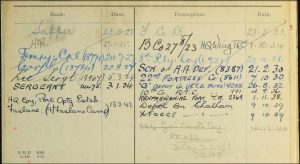
Commissioned – (London Gazette 17th April 1942.) War Substantive Lieutenant 20/03942, Temporary Captain 27/12/1942 (ref Army List April 1944).
He was mentioned in despatches, London Gazette 22nd March 1945 in recognition of gallant and distinguished services in North West Europe.
Required reading is the fine book, of which a copy is supplied with the group – A HARBOUR GOES TO WAR (The story of Mulberry and the med who made it happen) by J.Evans, E. Palmer, R,. Walter.
In this superb and detailed work there are numerous references and mentions to CAPTAIN TARLING. In the Personae preface he is described as “CAPTAIN 969 AND 970 COMPANIES TO PLANT FLOATING PIERS.”
When orders were given to start planning the operation all RE units in the UK were instructed to send their finest. bravest and highly skilled soldier to join the crack invasion force. In actuality the units used this as an opportunity to send their worst and “most desperate” criminals. Tough looking men clutching their crime sheets of every possible crime….. this sounds redolent of the story of the Dirty Dozen.
Tarling, with his team of experienced NCOs, from the Spring of 1944 began to turn this company of men into soldiers. The “rejects” pillaged local villages, set fire to Glasserton House and wrecked equipment at Ryde, Isle of Wight. By the end of May CAPTAIN TARLING had 22 Court-Martials. A visiting Colonel remarked that the men would never make soldiers and called the “a bunch of Goons”. In the event the Goons were magnificent.
On embarking on the City of Canterbury Tarling was heard to use the Duke of Wellington’s phrase – “I don’t know what they will do to the enemy but, by God, they frighten me”.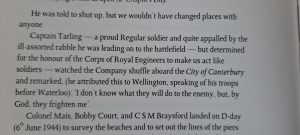
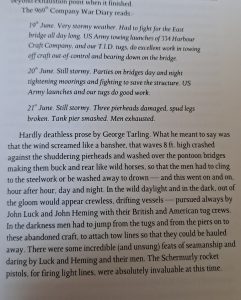 They landed D+1 Day (7th June) at King’s Beach (La Riviere). CAPTAIN TARLING wrote the 969th Company War Diary and records, in a very understated fashion, the terrible weather. Detail is given of the extremely violent seas and the utmost danger faced by the incredibly committed teams of Officers and Men.
They landed D+1 Day (7th June) at King’s Beach (La Riviere). CAPTAIN TARLING wrote the 969th Company War Diary and records, in a very understated fashion, the terrible weather. Detail is given of the extremely violent seas and the utmost danger faced by the incredibly committed teams of Officers and Men.
Without doubt CAPTAIN GEORGE TARLING most certainly played a very critical role in the success of the operation.
Medal group, court mounted as worn – 1914/15 Star, British War Medal and Victory Medal ( S-6978 PTE. G. H. TARLING. RIF. BRIG. ), 1939/45 Star, France and Germany Star, Defence Medal, War Medal with M.I.D. emblem, Long Service and Good Conduct Medal ( 1863081 SJT. G.H. TARLING. R.E. ), Meritorious Service Medal (GVIR) ( 1863081 W.O. CL. 1 . G.H. TARLING. R.E. )
George Harrison Tarling of West Cliff Road, Bournemouth died 17th July 1983.
Additional Recommended reading for a first hand insight into the extraordinary and dangerous work carried out by the Officers and Men to making a success on the Normandy landing please read the following:
The below writings, in which Tarling features frequently, are the REMINISCENCES OF R J P COWAN, ROYAL ENGINEERS to be found on the fine The Scots at War Trust website and .
For me, Mulberry started in January 1944. We were building bridges over oddly named rivers in the Italian mountains when I was ordered to fly back to the United Kingdom as fast as possible. On arrival I reported at the War Office where, with other poor fellows, we were sworn to absolute secrecy and “briefed” by high-ranking officials. We were shown a model of the “Mulberry” (I don’t know who thought up the name) Harbour. We were told that huge concrete cassions would form a protective breakwater enclosing a harbour of 1300 acres (i.e. as big as Dover) that there would be steel pontoon pierheads with “spuds” (whatever they were), and that these pierheads would be connected to shore by three-quarter mile long pontoon bridges.
A vast project indeed and we were most impressed; but then they told us that the whole thing had to be towed across the channel and put together in days, at some un-named place on the enemy shore. We didn’t dare laugh – because they seemed serious – but felt slightly sick. We were told that we should be proud to have been selected by the Corps of Royal Engineers to take part in this operation; that we (the 969th and 970th Port Floating Equipment Companies) would be responsible for the construction of the piers and pierheads in the field. The success of the invasion of Europe depended (they said) on us. In fact, they told us that “This project is so vital that it might be described as the crux of the whole operation” (this was quoted from a Memo to the First Sea Lord of the Admiralty from the Combined Chiefs of Staff).
I was not at all thrilled by this information: quite apart from a natural reluctance to get involved in anything that looked so dangerous, I was appalled to think that the British Army was so truly desperate, so near the bottom of the barrel, that they had to choose me. And, if it were really true that the success of the assault on Europe depended in any way on me, then I could not see much hope for the Allied Armies.
DESPERATE MEASURES
Something of these unhappy thoughts must have shown in our faces (my forebodings were shared by the others); we were assured that orders had already been passed to every other R.E. unit in this United Kingdom to send, immediately, their finest, bravest and most highly skilled soldiers to join this crack invasion force, because “Mulberry Must Not Fail”. It all sounded most impressive and, as we left the War Office and walked along Northumberland Avenue, we envisaged a stream of clear eyed, fit, clean, splendid, young soldiers on their way to join the various sections of the Company – in Scotland, in the Isle of Wight, and Selsey.
Alas, what really happened was that every unit in the U.K. seized this golden opportunity to “unload” on to us their most formidable and desperate criminals – tough looking men arrived clutching Crime Sheets covering every known offence (in the Army Act) – insolence, theft, wife beating, assault and battery, robbery with violence, larceny, desertion etc. etc. As they paraded we eyed each other – it was obvious that they didn’t think much of us, while we could tell that Mulberry and the invasion was not going to be a success.
In the spring of 1944, in March, April and May, Captain Tarling and his experienced N.C.O.s gradually began to turn the very mixed company of men into soldiers. This was a most difficult task, the “rejects”, the “hard men” sent to us by other Engineer Units managed to pillage and loot the surrounding villages, they set fire to Glasserton House (in Scotland), they wrecked a great deal of valuable equipment at Ryde; poor George Tarling had some 22 Court-martials in process or pending at the end of May.
A BUNCH OF BLOODY GOONS
A visiting Colonel, watching an unhappy squad being trained in the use of the Bren gun on the lawn at Glasserton House remarked, “These men will never make soldiers; what a bunch of bloody goons”. The name stuck but in the event the “Goons” were magnificent.
We constantly begged Colonel Mais for a full scale exercise – which he was most anxious to arrange. Towards the end of May. In May he told us that a rehearsal had been arranged, the date fixed, the 6th of June. Next we heard – and the Colonel was oddly coy and evasive – that this exercise had been postponed – but we must not worry, we would be given a chance to put the equipment together under the most rigorous conditions “very soon”.
Later on Raymond Mais told us how, enraged at this postponement, he had stormed into 30 Corps Headquarters and demanded that his men must be allowed to practice with the equipment before “D Day”. He was taken aside by a Colonel of Intelligence who told him that there were very very good reasons why the exercise could not be held. Mais still refused to accept this and continued to argue; the Intelligence Officer, with a hopeless look on his face, asked “cannot even you think of one day on which you will be otherwise engaged[?]”.
At last the penny dropped and Colonel Mais realised that the date for the invasion had been fixed – for 6th June, 1944.
The main body, with Tarling, Simpson, Rigbye and myself landed on D+1 Day…
Wally Walter and Raymond Mais had started to tell us what tasks had first to be done when, round the corner into the esplanade, came an old Frenchman, his wife and daughter. It was obvious that they were frightened to death, the woman weeping and only native pride was keeping the old man going. They stopped short and stared at us – wondering if we were friend or foe. Wally Water and Raymond Mais looked up, saw them, put down their mapcases, walked over and both saluted the old Frenchman – salutes the Brigade of Guards could not have bettered.
In absolutely appalling French – an indictment of the English Public School system – Raymond Mais congratulated the old fellow on bringing his ladies to safety through the enemy lines and expressed the hope that he would accept the hospitality of the British Royal Engineers. The gallant old Frenchman, his pride and dignity restored in the eyes of his womenfolk, turned on the ladies and told them to stop crying. They were led away and given hot tea and food and accommodation by the Sergeant-Major.
The weather during these days was not good, the sea was choppy. The long (480ft.) pontoon bridge tows had to be manoeuvred by the tugs into line and the exact moment taken to “slot” the “free” span into the trumpet guides at the bridge end. A miscalculation by John Luck and Heming [tug captains] and their crews at this point could maim, even kill, the bridge crews (Simpson was nearly sliced in two, and knocked unconscious by a girder on one rough, choppy afternoon) but mutual trust and confidence was such that by 12th June, in spite of the poor weather, 1520 ft. of the centre pontoon pier had been built, 2160 ft. of the east pier and 960 ft of the special tank landing pier. Even George Tarling had to admit that the men, the “bandits” (“the Goons”) included, were working hard and well.
TERRIBLE CONDITIONS
The equipment was excellent and, although the conditions for erection were much worse than envisaged by the designer, Joe Beckett (who was everywhere, even working with a rat-tail spanner – he also developed a simple, quick method of laying the kite anchors) the Sappers were soon expert in handling it. Daily, armour and infantry landed at the piers. Standing at the roadside above the growing port and watching the troops move inland I was struck by the number of men who waved and shouted greeting to Colonel Mais and George Tarling, recalling other places, other campaigns. I remarked on this and George Tarling, with some emotion, said that you always met the same nice chaps at the “sharp end”. His son was fighting with an Armoured Division a few miles away and, whenever he could, George would slip away to see him. (his son later died in action in the Malaya Emergency).
At this point a Glasgow voice called “Get off your fat backside, Cowan, and do some work”. Turning round I was delighted to see my old friend Bill Taylor (now a Colonel in the Cameronians); he told me that he was with the Canadian Army. We had served our apprenticeships together. I had heard that Bill had been killed during the retreat in France in 1940 but, alive and well, he waved goodbye and set of in his jeep towards Bayeux. I felt that I had joined a very exclusive club.
Captain Tarling saw to it that we were always well fed, hot food was ever available. We understood that he sent raiding parties round the ships in the harbour – our thieves and burglars were put to good use, so we fed very well indeed.
The lesson – make the best use of the talents of your men.
At first, we slept under hedges with ground sheet cover, but had established an Officers’ Mess (run by driver Johnny Davidson) in a small abandoned cottage. George Tarling had “suggested” to our light fingered soldiers that decent furnishings would be appreciated and soon we had armchairs and were dining in luxury with tablecloths, by candlelight, with gleaming cutlery and crockery (even a soup tureen) all of which had been “lifted” from various sources.
On 19th June (D+13) a storm began “such had been seen in the Channel for over 80 years – second only to the one that smashed the Spanish Armada in 1588” (Chapter XII, “The Story of the Mulberries”). It continued for 4 days – 4 days and nights which no one who served at Arromanches will ever forget. Tired out when it started, the men were far beyond exhaustion point when it finished.
The 969th Company War Diary reads:- 19th June. “Very stormy weather. Had to fight for the East bridge all day long. U.S. army towing launches of 334 Harbour Craft Company and out T.I.D. tugs do excellent work in towing off craft out-of-control and bearing down on the bridge.” 20th June. “Still stormy. Parties on bridges day and night tightening moorings and fighting to save the structure … 21st June. “Still stormy. Three pierheads damaged, spud legs broken. Tank piers mashed. Men exhausted.” 22nd June. No entry – Everyone was on the piers.
CRASHING WAVES
Hardly deathless prose by George Tarling. What he meant to say was that the wind screamed like a banshee, that waves 8ft. high crashed against the shuddering pierheads and washed over the pontoon bridges – making them buck, snake and rear like wild horses, so that the men had to cling to the steelwork or be washed away to drown – and this went on and on, hour after hour, day and night. In the wild daylight and the dark, out of the gloom would appear drifting vessels – pursued always by … [the] tug crews. In the darkness men had to jump from the tugs and from the piers on to these abandoned craft to attach tow lines so that they could be hauled away. There were some incredible (and unsung) feats of seamanship and daring by Luck and Heming and their men …
The crisis came in the late afternoon of the third day of the storm, just as darkness was falling.
A steel pontoon, blown in by the wind and strong tidal currents, had become lodged underneath one of the bridge spans. With each wave it crashed against the steel trusses and was smashing the end of the concrete “beetle”. Bill Rigbye, Dennis Barton, Sergeant Allen and Sapper Edwards had somehow managed to leap on to the wet and greasy steel deck of the heaving pontoon. Rigbye had hurt his ankle and, unable to move, clung there with the waves breaking over him. As the wind and seas drove the pontoon over further beneath the bridge girders the position was becoming desperate, it was only a matter of minutes before Rigbye was smashed and crushed. As I arrived with “Doc” Smith we found Raymond Mais and Arthur Hirst balanced on the steelwork trying to judge the moment to jump on to the pontoon.
In broad daylight, in dry weather, these leaps would have been extremely hazardous; in the half light, for exhausted men, their reactions slowed by fatigue, it required a special sort of courage. But they succeeded, somehow a line was passed to Luck and Heming, who had edged the sterns of their tugs as close as they dared, and the pontoon was tows [sic] away. A wet and cursing Rigbye was rescued and the bridge was saved. On the pierheads Ted Witcomb had “spudded up” (far beyond the makers wildest nightmare) so that the warning lights on the control panel were permanently on “Red” and the warning buzzers shrieked day and night. No place for the faint hearted. In spite of all he could do, spud legs failed and dragged on the bottom. But Whitcomb’s courage never failed, he kept his nerve and rode out the storm.
During the night of the third day Brigadier Walter[s], Colonel Mais and George Tarling decided to visit the spud pontoons to see Witcomb. After a frightening walk along the ¾ mile of heaving and undulating bridges, holding on as the waves broke over them, they arrived. The pierheads were awash, shuddering; the noise of the wind, the screech of the spuds grinding on the rocky sea bed the banging and crashing of the spud legs in the guides, was indescribably, frightening.
In the grey dawn they eventually found Ted Witcomb and Jones with a party of men working at makeshift repairs. They were soaked, unshaven, exhausted, the skin below Witcomb’s eyes had fallen away, only the spirit of the man was keeping him going. Wally Walters (now himself so tired that he repeated every order twice, just to make sure he had given it) at once told Tarling to go back for a rum ration as fast as he could – and poor George (in not much better shape than Ted) set off back along the pontoon bridge towards the shore.
The Brigadier and Raymond Mais were desperately concerned about Witcomb and his men, any of whom could have sleep-walked over the side at any time. Witcomb, courteous and articulate as ever, thanked them for visiting him, offered cans of self heating chocolate (he said his crew lived on these cans during the storm …). Asked if he could hold on, Ted replied that he could … but said that “things were never so bad that they couldn’t get worse” – and he was right, for almost at once there was an appalling crash as a tank landing craft … crewless, the front door hanging open, had been blown against the pierhead and, with the action of the waves, was smashing itself to bits – and the pierhead deck as well.
Then out of the grey half-light, rearing and plunging on the waves, came Johnny Luck, Pollard and Heming in the towing launches. Witcomb and his men managed to attach a tow line and, with their rocket pistols, they got the line to the tugs …
PAYPAL is NOT available for this item. Overseas buyers must contact us to agree shipping prior to order. Email ttandm4h@outlook.com for details or call 07765 595662 to arrange.
Card Payment on Checkout, Bank Transfer (Account name: ttandm4h, Sort Code 30-94-41, Account number 48469068).
Part Exchange welcome.

